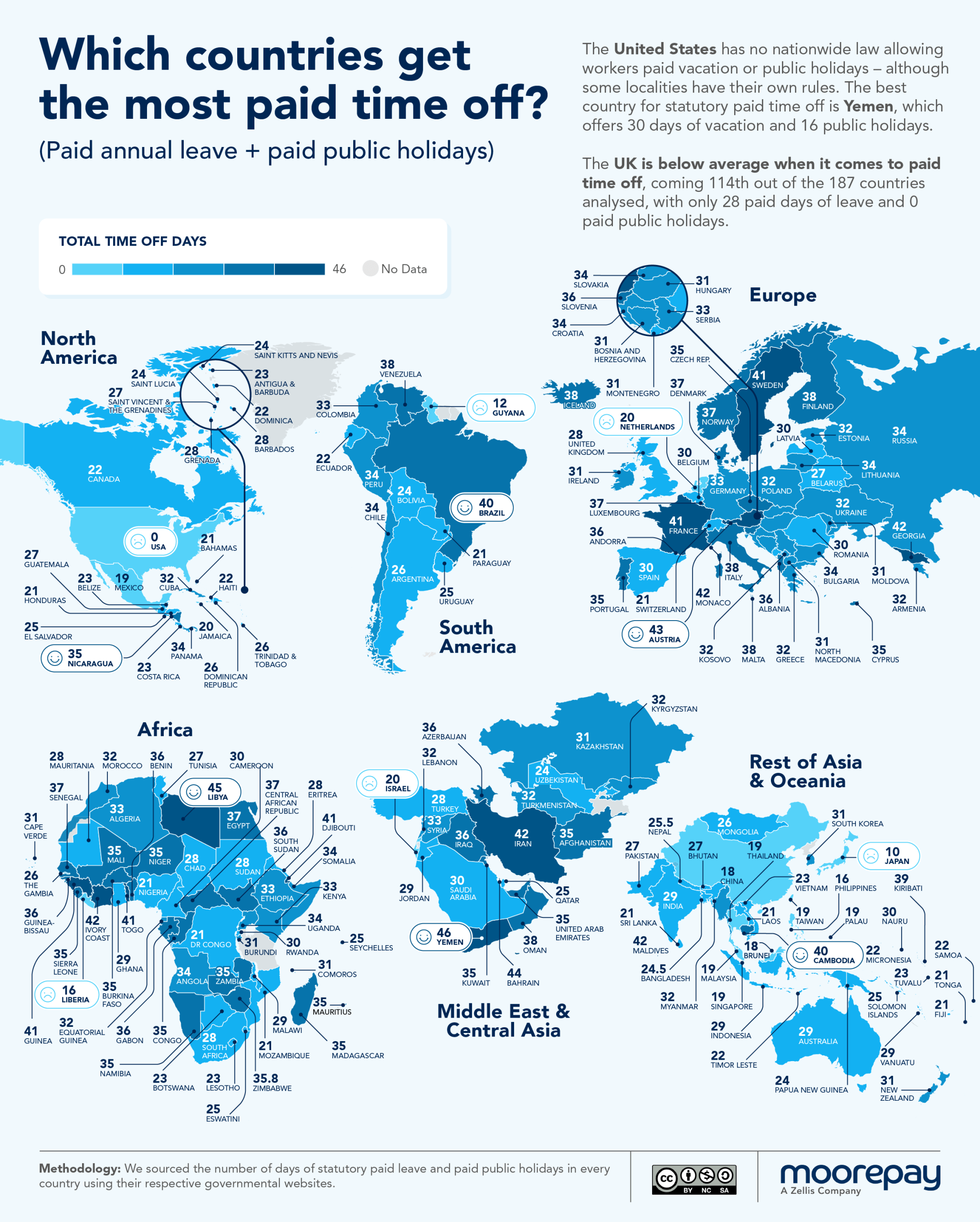Countries with the Most Time Off Map


David Chen
Data Visualization Specialist
David Chen is an expert in transforming complex geographic datasets into compelling visual narratives. He combines his background in computer science ...
Geographic Analysis
What This Map Shows
The "Countries with the Most Time Off Map" provides a visual representation of how various nations allocate vacation days, paid leave, and public holidays to their workforce. This map is not just a collection of data points; it illustrates cultural attitudes towards work-life balance, employee well-being, and national policies that prioritize time away from work. It captures the essence of how different societies value rest and leisure, revealing a fascinating tapestry of labor practices around the globe.
Deep Dive into Time Off Policies
Time off policies are crucial for maintaining the physical and mental health of employees. Many countries have established laws that stipulate a minimum number of vacation days and paid leave. For instance, countries in the European Union typically offer generous vacation time, with many nations mandating at least 20 to 30 days of paid leave annually. Interestingly, France stands out with a statutory minimum of 25 vacation days, along with numerous public holidays that further enhance the time off for workers.
In contrast, the United States is often noted for its limited vacation policies. Here, there’s no federal requirement for paid vacation days, leading to a culture where many employees forfeit their time off. Studies have shown that American workers average only about 10 to 15 days of vacation per year, a stark contrast to their European counterparts.
Beyond vacation days, public holidays also play a significant role in determining how much time off individuals receive. Countries like Japan and South Korea may have fewer mandated vacation days, but they compensate with a high number of public holidays, which can lead to extended breaks throughout the year. For example, Japan celebrates numerous traditional festivals that allow for additional days off, enhancing the overall time away from work.
Interestingly, some nations have begun to recognize the importance of mental health days and flexible work arrangements. Countries like Sweden and Denmark prioritize work-life balance, often allowing employees to take time off for personal reasons without stigma. This approach not only promotes well-being but can also lead to increased productivity and job satisfaction.
Regional Analysis
When examining the map, several regional patterns become evident. In Western Europe, for instance, countries such as Germany, France, and the Nordic nations lead the way with substantial time off policies. Germany mandates a minimum of 20 vacation days and has several public holidays, making it a strong advocate for employee rights and well-being.
Conversely, North American countries, particularly the United States and Canada, exhibit a more conservative approach. In Canada, while there are legal minimums for vacation days, many workers still feel pressured to work through their holidays, leading to a culture of presenteeism.
Moving to Asia, we see a mixed picture. Countries like India and the Philippines have relatively high numbers of public holidays, but the actual vacation days may not be as generous. In contrast, nations like Singapore offer a balanced approach, combining vacation days with public holidays to promote a healthy work-life balance.
Interestingly, in South America, countries like Brazil offer a generous 30 days of vacation, yet many workers still find it challenging to take full advantage of their time off due to workplace pressures or economic constraints. This highlights the complex relationship between labor laws and cultural expectations.
Significance and Impact
Understanding which countries provide the most time off is more than just trivia; it reflects broader societal values and economic conditions. Countries that prioritize time off tend to foster happier, healthier workforces, which can lead to increased productivity and innovation. Furthermore, as globalization continues to influence labor markets, the conversation around work-life balance is becoming increasingly important.
Current trends indicate a growing recognition of the importance of mental health, prompting even traditionally conservative countries to reconsider their policies. For instance, the rise of remote working arrangements during the COVID-19 pandemic has sparked discussions about flexible work hours and the ability to take time off when needed.
Looking ahead, it’s fascinating to consider how these trends might evolve. As employees across the globe demand better work-life balance, we may see a shift in labor policies, leading to more countries enacting laws that ensure a healthy amount of time off.
Ultimately, the conversation about time off policies is not just about days marked on a calendar; it’s about creating a culture that values rest, rejuvenation, and the well-being of individuals. As the map illustrates, the variations in how nations handle time off can reveal much about their priorities and values.
Visualization Details
- Published
- August 15, 2025
- Views
- 124
Comments
Loading comments...